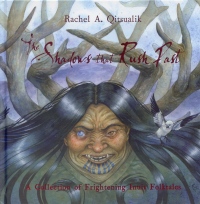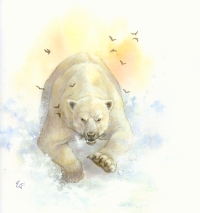| ________________
CM . . . . Volume XVIII Number 18 . . . . January 13, 2012
excerpt:
Scary stories often start with a tease such as that in the excerpt above, one that immediately creates worry about what will happen to the poor nameless boy caught outside in the cold. Each of the four frightening and imaginative tales in this extraordinary book will excite and terrify young readers while it educates them about centuries-old Inuit mythology and culture.
The myths and legends of the past can be a touchstone and a guide for the future. The tenuousness of surviving the elements and harsh geography of the North inform these myths – they are rough, brutal, full of violence, blood and death. "Nanurluk" is the tale of how a brave hunter, Nakasugnak, bravely kills a bear that is one hundred times the size of a normal bear. He allows the monster to swallow him, whereupon he stabs and mortally wounds the animal from the inside of its gut. Life, though, is cruel. While he could defeat the biggest monster, he, himself, is beaten by the smallest enemy. Naksugnak ignores the warnings of the people who advise him to stay hidden when clouds of biting insects attack the camp.
Each story ends with Pijariiqpunga (all I have to say) – indicating that the teller knows the story and the lessons are to be taken as they are. The larger-than-life illustrations show frightening beings thundering over the bleak landscape. Children will study the skilfully rendered pictures by Emily Fiegenschuh and Larry MacDougall. They are beautiful and have a contemporary look, and they are the reason most children will first pick up the book. The text is printed in a brown-ish tone, appropriate to complement the natural environment of the North. The Shadows That Run Past will be an excellent read-aloud, a useful component in a unit about the Inuit, the North or myths and legends, and will add vibrancy to a library collection. Highly Recommended. Harriet Zaidman is a teacher-librarian in Winnipeg, MB.
To comment
on this title or this review, send mail to cm@umanitoba.ca.
Copyright © the Manitoba Library Association. Reproduction for personal
use is permitted only if this copyright notice is maintained. Any
other reproduction is prohibited without permission.
NEXT REVIEW |
TABLE OF CONTENTS FOR THIS ISSUE
- January 13, 2012.
AUTHORS |
TITLES |
MEDIA REVIEWS |
PROFILES |
BACK ISSUES |
SEARCH |
CMARCHIVE |
HOME |

 Collected and written by northern writer and educator Rachel A. Qitsualik, The Shadows That Rush Past is an important contribution to Inuit and Canadian lore. As climate change, mining and urban living bring an end to any vestiges of the traditional way of life, the stories about how people live will change too. Written in a conversational tone, using irony and suspense, the stories will draw children into a time and place in the past, and stay with them for a long time.
Collected and written by northern writer and educator Rachel A. Qitsualik, The Shadows That Rush Past is an important contribution to Inuit and Canadian lore. As climate change, mining and urban living bring an end to any vestiges of the traditional way of life, the stories about how people live will change too. Written in a conversational tone, using irony and suspense, the stories will draw children into a time and place in the past, and stay with them for a long time.